Porcelain Insulator News
by Elton Gish
Reprinted from "Crown Jewels of the Wire", May 2000, page 12
In July 1999, we discussed two rather large wall entrance tubes. The white
tube was about two feet long, six inches in diameter and dated 1906. The smaller
brown-glazed tube was nearly three feet long and 2-1/2" in diameter. It had
the "THOMAS" marking on one end. We now know that this is actually the
inner tube of the wall entrance tube similar to that shown in the illustration
from the 1920 Thomas catalog. Wall entrance tubes were used to insulate the high
voltage conductor cable as it passes through the wall of a substation. The
photograph shown on the following page from the 1925 Locke catalog shows several
conductors entering the substation through wall entrance tubes mounted in the
upper part of the outside wall.
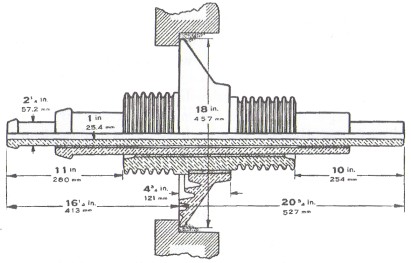
Illustration of Thomas wall entrance tube from the 1920 Thomas catalog.
Note
the long slender inner tube through which the high voltage cable passes.
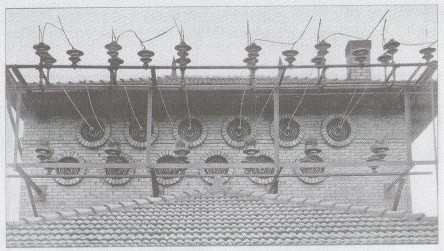
This photograph from the 1925 Locke catalog shows wall
entrance tubes mounted
in the brick wall of a substation.
The first wall entrance tubes were made from 12" sewer pipe tiles. This
worked well for up to 10,000 volts, but higher voltages required greater
insulating qualities. Fred Locke patented the original design for wall entrance
tubes. Patent No. 870,187 was granted on November 5, 1907. The design is similar
to more modem tubes with a porcelain tube to carry the conductor cable and one
or two porcelain disks in the center. Fred Locke's second patent, No. 878,646,
was granted on February 11, 1908. This novel design was made up of two or more
concentric tubes cemented inside each other. The tubes provided petticoats that
effectively increased the leakage path much like petticoats under a standard
pin-type insulator.
Mike Spadafora found three wall tubes about a year ago in an
old substation in the northwest that were made based on Fred Locke's 1908
patent. The tubes were mounted in a wooden panel set in the wall and held in
place on the inside by a galvanized metal band fixed around the outer tube.
These are rather small tubes composed of three concentric porcelain shells
cemented together. The design is very strong and provides a very long electrical
leakage path. Unfortunately, none of the tubes were marked but the glaze was
obviously early Locke circa 1905.
Locke catalogs offered this type of tube for
many years. Some consisted of up to seven tubes and the largest size weighed 240 lbs! Usually
wall entrance tubes are cemented into a brick or concrete wall. This type of
wall entrance tube was designed to be mounted in a panel of varnished wood, slate, marble, or glass. The specification called
for the panel to be twice the diameter of the insulator.
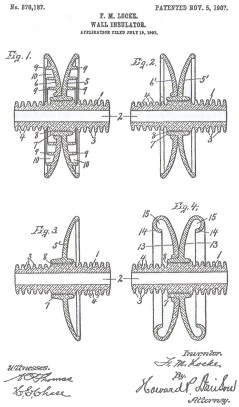
Medium Image (65 Kb)
Large Image (162 Kb)
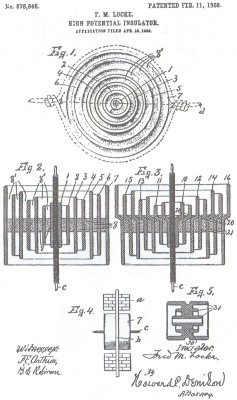
Medium Image (78 Kb)
Large Image (200 Kb)
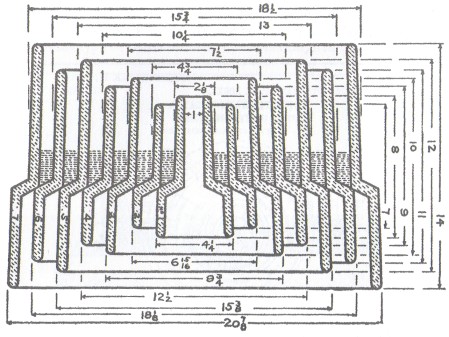
Fred Locke style wall entrance tube from 1910 Locke catalog.
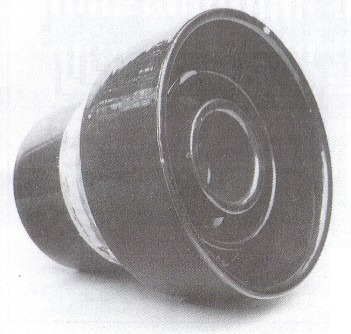
Early Locke wall entrance tube (circa 1910)
found by Mike Spadafora.
Many of you know Ken Willick (NIA #3709) who lives in Fred Locke country at
Lima, NY. Ken likes to dig in the local Fred Locke dump in nearby Victor and
usually comes up with some very interesting items. I'm a bit late reporting this
but Ken's digging a couple of years ago turned up a whole host of interesting
and varied insulators. Unfortunately, most were badly damaged. On one of his
hunts, Ken "stumbled over" a previously unknown dump site. His first
clue was an unmarked U-441A sitting right out in the open. Quickly raking the
area and digging around yielded many shards and a few decent specimens of U-4,
U-108, U-196, U-259, U-330, U-441A, U-608, U-611A, U-639, U-648, U-669, U-925,
U-949, U-954, U-957, U-964, and a large variety of early multipart pieces all
from the Fred Locke era. He also found a specimen of U-520 with a
"VICTOR" incuse marking. This is the only known example of this style
that was shown only in the 1910 Locke catalog. In addition, Ken found an unusual
broken piece that has threads on the outside and was obviously glazed below
that. This appears to be one of Fred Locke's early suspension insulators made
based on patent No. 779,659 (January 10, 1905). Here are a few photos of Ken's
dump finds.
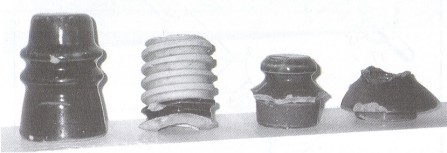
Fred Locke dump items:
U-108 N-N, top to Fred Locke suspension,
U-330
"P. M. Locke", and U-330 N-N
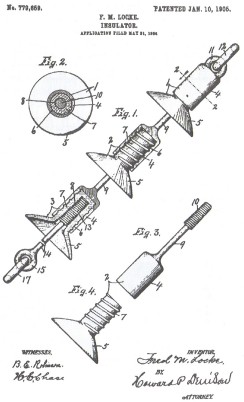
Medium Image (52 Kb)
Large Image (119 Kb)
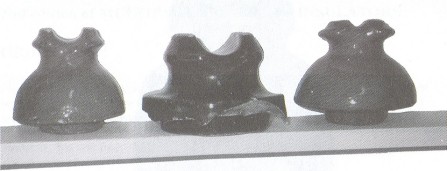
Fred Locke dump items:
U-648 N-N, U-520 VICTOR, and U-669 N-N.
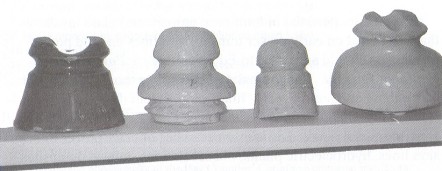
Fred Locke dump items:
U-441A F. M. Locke, U-196 "B-7-2"
under-glaze ink marking,
U-4 incuse "F. M. Locke" with white glaze,
and U-639 "F. M. Locke" marking.
Ken reported one more interesting rare insulator he purchased for his
collection. It is U-560 with tan glaze and Imperial Porcelain Works marking. It
also has a manufacturing date around 1903 or 1904. Fred Collier, Jr. (NIA #2933)
has one with the Imperial crown logo marking. These are the only two brown
U-560's known with Imperial markings.
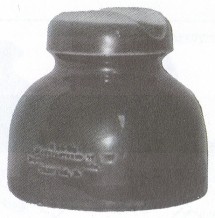
U-560 Imperial with metallic tan glaze.
If you are interested in multipart, unipart, and glass insulators that were
used on early power transmission lines and old power plants, you should
subscribe to Ed Sewall's new Power Line Explorer Journal. The journal will
encourage those actually out researching and hunting early lines to document
their finds, regardless of how small. Each issue of Power Line Explorer Journal
will contain several detailed articles on searches of early power transmission
lines, hydroelectric plants, old substations, mines, dumpsites and any other
place insulators were used. Additionally, articles documenting historical
research from enthusiasts around the country on insulators and early power
transmission systems will also be published in this journal. Early porcelain and
glass power line insulators as well as associated items such as pins, wall
tubes, conductors, pole line construction etc. will be the focus of the
articles. Several regular columns are also anticipated to be featured in future
issues. Enjoy the history and thrill of the hunt! The Journal is highly
recommended.
Contact Ed Sewall if you would like to subscribe
(annual subscription $6).
(E-mail: plej@insulators.com)
(see ad on page 35 of this issue)
| 